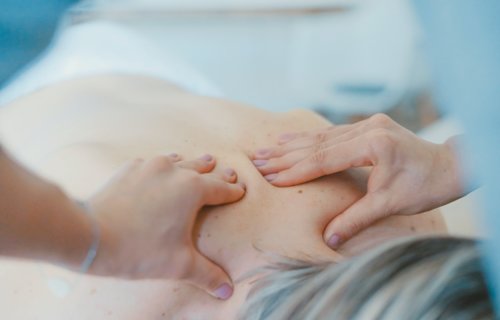BOSTON, Mass. — Massages don’t just relax your body, they make your muscles heal faster and stronger, a new study reveals. People have been treating sore and injured muscles with this technique for more than 3,000 years. Today, many athletes swear by the practice to help rehabilitate their bodies after intense exercise. In experiments with mice, researchers from Harvard’s Wyss Institute for Biologically Inspired Engineering and John A. Paulson School of Engineering and Applied Sciences found that mechanotherapy not only helps soothe muscles, it actually improves the healing process after severe injuries.
Using a custom-designed robotic system, the research team delivered a consistent force that mimicked massage strokes into the legs of mice. They found that the robotic system, which delivered the mechanical loading to the bones, rapidly cleared the immune cells, called neutrophils, out of the severely injured muscle tissues. This process also removed the inflammatory proteins, called cytokines, released by the neutrophils from the muscles, which enhanced muscle fiber regeneration — a process that is critical to healing.
“Lots of people have been trying to study the beneficial effects of massage and other mechanotherapies on the body, but up to this point it hadn’t been done in a systematic, reproducible way. Our work shows a very clear connection between mechanical stimulation and immune function. This has promise for regenerating a wide variety of tissues including bone, tendon, hair, and skin, and can also be used in patients with diseases that prevent the use of drug-based interventions,” explains Dr. Bo Ri Seo, first author of the study, in a university release.
The right amount of pressure can spark the healing process
Study authors started exploring the effects of mechanotherapy on injured tissues in mice several years ago and found that it doubled the rate of muscle regeneration and reduced tissue scarring over the course of two weeks. Excited by the idea that mechanical stimulation alone can foster regeneration and promote muscle function, the researchers decided to probe deeper into how the process worked in the body, to figure out how to maximize the healing process. They teamed up with “soft robotics” experts at the Wyss Institute, led by Dr. Conor Walsh, a professor of Engineering and Applied Science at SEAS, to create a small device that used sensors to monitor and control the force applied to the limb of a mouse.
“The device we created allows us to precisely control parameters like the amount and frequency of force applied, enabling a much more systematic approach to understanding tissue healing than would be possible with a manual approach,” says robotics engineer Dr. Christopher Payne.
Once the device was ready, the team applied pressure to the leg muscles of the mouse via a soft silicone tip and used an ultrasound scan to look at what happened to the tissue in response.
Study authors used the ultrasound data to develop a model that could predict the amount of strained tissue after applying different levels of pressure to the injured area. They then applied the consistent, repeated force to the injured muscles for two weeks.
Should you opt for the light touch or strong rub?
While both the treated and untreated muscle fibers showed signs of healing over that period of time, the treated muscles showed a more pronounced improvement, which indicated that the treatment was successful. The scientists also found that when they applied a greater force, the injured muscles became stronger, which confirmed that mechanotherapy improves muscle recovery after injury.
The team also confirmed that the force applied to the muscle by the mechanotherapy effectively squeezed the neutrophil immune cells and cytokine proteins out of the injured tissue. They ran further tests on how these immune cells affect the regeneration of muscle fibers.
“These findings are remarkable because they indicate that we can influence the function of the body’s immune system in a drug-free, non-invasive way. This provides great motivation for the development of external, mechanical interventions to help accelerate and improve muscle and tissue healing that have the potential to be rapidly translated to the clinic,” Dr. Walsh concludes.
He and his team have worked to develop wearable technology for diagnosing and treating diseases. The researchers also hope to test it on different types of injuries, including age-related muscle loss and muscle performance enhancement.
The findings appear in the journal Science Translational Medicine.
South West News Service writer Georgia Lambert contributed to this report.
